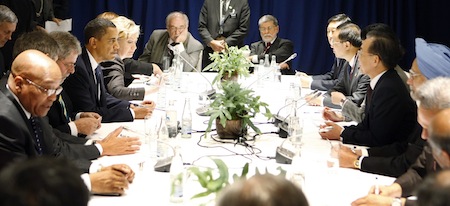Asia and World (dis)Order...
More on:

For 30 years, the G7 ruled the roost--Americans, Canadians, Europeans, and Japanese. And with the exception of the Japanese, there was nary an Asian in sight. The G7 took the big decisions about the international economy. And with the many opportunities for side meetings on strategic and political issues, G7 summits became, in many ways, the top table of international relations.
But last week in Copenhagen, the United States hashed out a climate deal with Chinese, Indians, Brazilians, and South Africans--and with nary a Canadian, European, or Japanese in sight. How extraordinary is this photograph? What about this one, as the President of the United States briefs European leaders on a deal he has already struck with China and India? The world has changed.
Out of the mayhem in Copenhagen, there are at least two pieces of good news about the United States, Asia, and the world:
First, what happened in Copenhagen puts the United States squarely at the center of efforts to address the mismatch between today’s international architecture and the realities of power and capacity. Those who create--or can solve--major international problems ought to be the ones at the table.
We don’t live in 1979, much less 1949. Yet the dominant international institutions, pacts, and agreements still reflect a world that is fast disappearing. Just look at the International Energy Agency (IEA), which coordinates oil stockpiles among major consuming countries. The IEA doesn’t include China and India--the two fastest-growing energy consumers in the world. And what kind of “international energy agency” is that?
It’s good, then, that international institutions are being updated--for instance, through the creation of the G8 Plus Five (Brazil, China, India, Mexico, South Africa), the emergence of the G20 (which includes additional Asia-Pacific powers, such as Australia, Indonesia, and South Korea), and the establishment of the Financial Stability Board. But unless real agreements are reached to deal with real problems, these steps will amount to little more than adding a few more deck chairs. Whatever one thinks of last week’s climate deal, at least the United States reached it with China and India.
The second piece of good news is that the agreement is likely to encourage a more ad hoc approach to global issues. In every crisis of recent years, the most effective global and regional problem-solving has been borne of necessity and focused on results. The most successful groups have assembled quick-moving countries, animated by the urgency of crises, which combine interest, resources, and expertise. They are unencumbered by ritualistic institutions and big international bureaucracies. And they focus on discrete, often imminent problems.
Take another look at that photo of Barack Obama, Wen Jiabao, and Manmohan Singh. They reached their agreement around a conference table. And that sort of ad hoc multilateralism reflects a straightforward lesson of recent years: first identify the functional problem, then assemble the right group of players. Put differently: avoid geometry for its own sake.
That’s the good news. But Copenhagen also raises three, more vexing issues:
First, where was Europe in American calculations? China and India are the big winners from recent efforts to update international decision-making but Europe is, quite clearly, the big loser. When the Bush administration championed IEA membership for Beijing and New Delhi in 2008, it quickly ran up against resistance from small European countries, whose weighted voting shares will be reduced if these Asian giants join the organization. How will the United States manage these transitions with Europe? And will the liberal values Americans and Europeans take for granted in so many international institutions become less relevant as China, in particular, assumes a greater role?
Second, what about Japan--a pivotal American ally in Asia that also ought to be a partner on global issues? Japan is undergoing a crisis of confidence, and its foreign policy is in transition. But the world’s second-largest economy, second-largest aid donor, and a U.S. ally of fifty years should be among America’s closest global partners. It’s not enough that Japan helps to maintain a balance of power in Asia. The U.S.-Japan alliance will stagnate, then become much less relevant, if Washington and Tokyo do not also concert their policies globally. But this will mean addressing divergent perspectives on the use of force and philosophical differences in American and Japanese approaches to international institutions.
Third, the coming era of major power relations is clearly going to be very complex. The United States and India have, in recent years, built a strategic partnership, and both Washington and New Delhi are ambivalent about the rise of Chinese power. Yet Chinese and Indian views in Copenhagen were far more congruent than American and Indian views. As I blogged last week, many in India increasingly fear a U.S.-China condominium on issues of direct importance to India. And Indians have become increasingly sensitive to suggestions that the United States looks to address global issues bilaterally with China, fearing that this will sideline New Delhi and work against Indian interests. But what happened in Copenhagen was quite the reverse. What conclusion, then, will the administration draw from India’s six daily coordination meetings with China in Copenhagen, or the fact that India and China “cooperated and collaborated each word at every step”?
More on:
 Online Store
Online Store